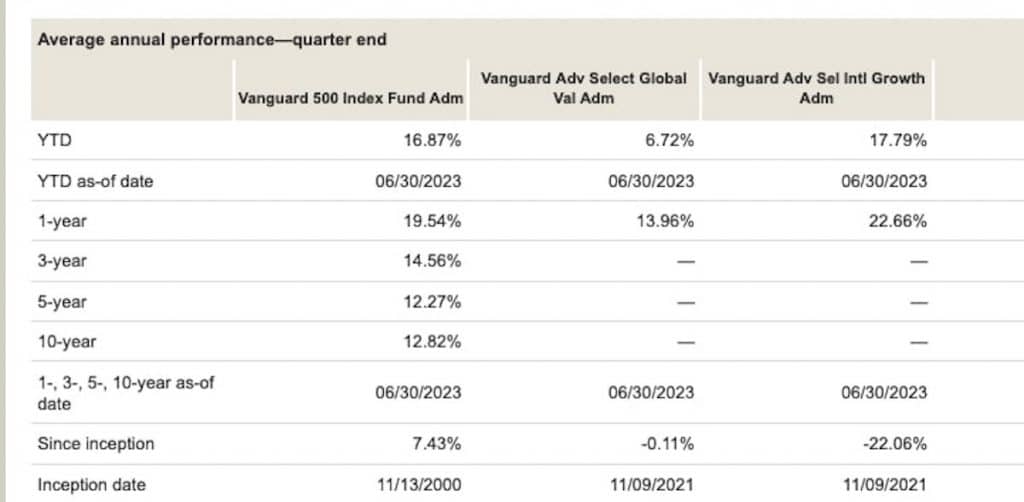
Mutual fund prices are available for any investor to see and fairly easy to calculate, with transparency on the current, real-time, and historical returns a fund has generated.
Mutual funds are a portfolio of investment assets, such as stocks, shares, bonds, and other securities. When you invest in a mutual fund, the fund itself is your investment rather than the collection of investment assets it contains.
Mutual funds are usually overseen by professional funds or money managers — although algorithmic trading now plays an integral role in the way most mutual funds are managed. Mutual funds play a huge role in the global economy, with over $63 trillion in assets under management (AUM) in open-end mutual funds, and they account for over 50% of most people’s pensions, retirement accounts, and 401(k)s, according to a 2021 Investment Company Institute report.
In this article, we will cover how mutual fund prices work, how you can track them, and how to invest in mutual funds.
How Are Mutual Fund Prices Calculated?
Because mutual funds are made up of a vast range of investments and asset classes ⏤ like stocks, shares, bonds, futures, real estate, commodities, and ETFs ⏤ the price is based on the change in the market cap of the overall fund. In other words, as the assets in the fund’s portfolio fluctuate every day, it’s the aggregate performance reflected in the price.
In the event of particular assets or whole asset classes underperforming against the fund’s investment goals, they’re divested, and better-performing assets are brought into the fund to adjust and correct for any losses.
Hence, the advantage of mutual funds being actively managed. This is often done with the assistance of stock backtesting tools, AI-powered auto investment tools, and analysts applying technical and fundamental analysis to individual asset classes.
With all of that in mind, the daily price you see for a fund is the NAV, also referred to as the net asset value per share (NAVPS). The price doesn’t fluctuate during the trading day. It’s only updated at the end of trading. The NAV or NAVPS is calculated based on the total value of every security in a fund portfolio by the total value of outstanding shares, e.g., those held by fund shareholders, fund officers, and insiders.
Fund gains are paid out over the year to shareholders in the form of distributions or dividends. If a fund sells a large block of shares that have appreciated in value, then the upside is passed onto shareholders minus annual fees, expense ratios, or commissions.
Shareholders need to factor these figures in because this impacts how much they will receive back in distributions, assuming the fund is performing well and generating a return. You can find these figures and a mutual fund’s investment objectives in the fund prospectus.
Where Can I Find Mutual Fund Prices?

For those wanting to track and invest in mutual funds, open-end mutual funds are available for anyone to view and invest in. The problem is, there are a lot of them. In the Investment Company Institute report mentioned above, there were 126,457 mutual funds worldwide as of the end of 2020.
As of 2022, there were over 137,000, according to recent statistics, and PwC estimates that total assets under management in mutual funds will exceed $145.4 trillion in 2025.
To find the current mutual fund prices, there are numerous dashboards, financial news services like Morningstar, and portfolio tracker apps. You can also use Tiingo’s End of Day Stock Price API to get real-time mutual fund prices and data.
What If I Invest $5,000 in Mutual Funds for 10 Years?

Source: Vanguard Investment Income Calculator
Most mutual fund providers offer free investment return calculators to give you an idea of what you could earn from their mutual funds. In order to determine how much you could earn within 10 years, you will need to determine how much you expect the yield percentage to be.
For example, the Vanguard Investment Income Calculator shows a $5,000 investment with a 5% yield would earn $250 per year. So after 10 years, you’d earn $2,500 from your initial investment.
However, as we can see from the image below, when comparing three completely random Vanguard mutual funds, the yields/dividends can be much higher (or lower) than the sample 5% we used above. For example, the Vanguard Advice Select International Growth Fund has a on-year yield of 22.66%, but since it’s inception in 2021, its percentage is -22.06%.

Source: Vanguard
In most cases, mutual fund investments are made ongoing, like pensions. Retail investors often put in an initial sum (e.g., $5,000), and then make continuous monthly payments, and watch their investment grow. If a fund isn’t performing as well as you’d want, then you can divest, diversify, and move your money to another fund.
It’s difficult to say that with any particular amount invested, a mutual fund will generate a specific return. Dividends or disbursements change over time, as a fund’s performance is aggregate based on how well (or not) the underlying assets perform. If the stock market went through a prolonged bear market, then naturally, mutual funds would also struggle to generate market-beating dividends.
The good news is mutual fund returns compound over time. A 10-year investment, starting with $5000 and an ongoing contribution of $100 per month, with an annual growth rate of 7%, could generate $10,000 in dividends, as per another mutual fund investment calculator.
How Useful Is Historical Mutual Fund Returns Performance Data?
As is always the case with investments, past performance doesn’t guarantee equal or better returns in the future. The money you invest is always at risk. That’s why there is value in a diversified investment portfolio and a proactive investment strategy.
That’s also an advantage of putting money into mutual funds. Your investment isn’t reliant on the performance of a particular company, asset class, commodity, futures contract, forex movements, or real estate asset. A mutual fund is diversified and de-risked by nature and proactively managed.
Historical performance data is useful and essential to review before committing to investing. It shows you how the fund has performed over time, and you can review this data right back to any fund’s inception. Simply pick a suitable data range and review the fund’s performance.
With market analysis tools, you can compare one fund against thousands of others. You don’t need to invest in the funds with the biggest names and AUM because everyone else does. Instead, you can apply an extensive range of analysis tools and methodologies to find the funds or funds that are right for your approach to investing.
Historical data needs to be weighed against your values, ethics, your short-term and long-term goals, your risk appetites, and whether you want fixed income or are willing to place a more strategic bet in order to win higher returns.
How to Invest in Mutual Funds
In most cases, mutual funds aren’t traded on stock exchanges, so you need to go to investment companies or brokers to track real-time prices and invest in these funds. For example, you can buy and sell mutual funds via Fidelity Investments, Charles Schwab, Vanguard, and other brokers.
However, there are exchange-traded mutual funds that operate similarly to exchange-traded funds (ETFs) or exchange-traded notes (ETNs). These are listed on exchanges, such as the NYSE, Nasdaq, and London Stock Exchange.
If you’re new to investing in mutual funds, here are a few steps to take to pick the right investment products for you:
- Decide your investment percentage allocation: How much of your investable funds are you wanting to put into mutual funds?
- Decide your investment goals: Do you want high-yield growth, or are you looking for steadier, more reliable returns? In this case, you need to look at value funds, bond funds, income funds, real estate funds, index funds, money market funds, and other safer, long-term fund-based investments.
- Look into mutual fund company providers: There are thousands of investment companies, banks, and pension providers that have billions in AUM, strong reputations and track records, and funds of every size, shape, and flavor. Some of these include BlackRock, Charles Schwab, Fidelity, and Vanguard Group.
- Do due diligence: Next, review an individual fund prospectus, past performance, historical prices, price history, dividend yields over specific time periods (e.g., three, five, or 10 years, etc.), and the investment strategy and track record of the investment management team responsible for the fund. In other words, review the data, and do your due diligence.
- Compare your options: Compare the fund performance against other funds you’re considering, and make sure to review the current asset allocation, liquidity, and investment strategy and goals.
- Buy into the funds you want: Make your choice, and buy shares in the fund (or several funds at once) through the provider’s website, a broker, or a third-party investment platform. Mutual funds trade once per day after markets close at 4 p.m. local time.
Remember, when buying shares in a mutual fund, you’re buying shares in the fund, not the underlying assets. A fund’s share price is based on an aggregate of the performance of the assets in that fund. Those asset classes can change over time as a fund adjusts for volatility to improve and optimize performance and achieve the dividend yields and objectives set out in the prospectus.
Make Smarter Mutual Fund Investment Decisions With High-Quality Data
Investing in mutual funds is considered a smart way to diversify and de-risk your investment portfolio. Mutual funds come in all shapes and sizes, and some generate higher yields with more risk, whereas others are safer bets. Knowing which one to invest in can take time and effort.
The best way to gain the insights you need quickly is to have access to high-quality, real-time, and historical data on mutual fund performance over time.
With Tiingo, you can gain access to as much data as you need through our APIs, including end-of-day prices and financial news, and these cover mutual fund performance and historical data.
Leave a Reply